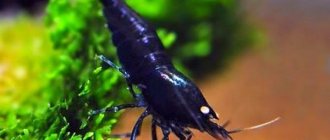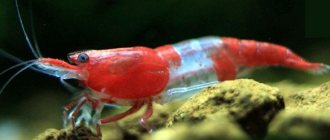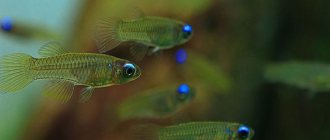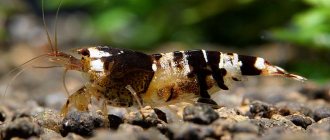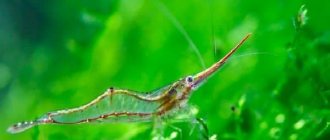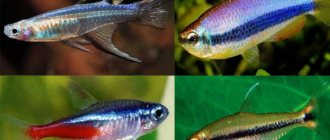These small creatures, inhabitants of the reservoirs of the tropical island of Sulawesi, were first introduced to the world of aquarium hobby in 2007. Miniature shrimp instantly gained popularity due to their spectacular color and ability to live in fresh water.
Sulawesi attracts with its unusual, bright body color - from reddish to burgundy and almost black with snow-white speckled dots in a blue edging or longitudinal contrasting stripes.
- Shrimp size: up to 1.5 cm
- Temperature: 27-29⁰С
- Content difficulty: difficult
- Behavior: peaceful
- Habitat layer: lower and middle
- gregariousness: gregarious
- Water pH: 7-8.5
- Water type: fresh
Cardinal shrimp photo
The Cardinal Shrimp is an amazing creature that is found in Lake Motano in Indonesia. Due to the fact that the water has rather rare characteristics, it is very difficult to keep shrimp at home. Despite its rarity, it can often be found in aquariums. If you want to purchase this shrimp for yourself, you should know that keeping this shrimp is not an easy task because it requires water conditions that are 98% similar to its native environment.
The Sulawesi Cardinal shrimp leads an active lifestyle. She almost never hides, she is always in plain sight. An interesting fact was noticed by aquarists: if you add Cardinal to the Sulawesi snail Tilomelania, then Cardinal will be much more active, because they will strive to collect and eat the algae accumulated on the shrimp’s shell, so they can be called aquarium orderlies. The Cardinal shrimp is approximately 1.5-2 cm in length and has a lifespan of up to 1 year.
There is another important fact: this type of shrimp is becoming extinct due to human activity on Lake Sule. For example, the extraction of oil and minerals - all this worsens the condition of the water in Lake Sulesky, and the Cardinal shrimp are dying out. Now they remain only in special tanks, where suitable water conditions were created especially for them, and in aquariums. Therefore, you need to treat this species with care.
Table of basic parameters of maintenance, care and nutrition:
| What should be the volume of an aquarium for an aquarium shrimp? | from 10 liters |
| What should be the temperature in the aquarium? | from +26-29°C |
| What pH should be in the aquarium? | from 7.8-8.2 pH |
| Potassium hydride in an aquarium | from 7-9 kH |
| Alkalinity of aquarium water | from 7-9 gH |
| Salinity of water in the aquarium | from 90-140 TDS |
| What should be the hardness of the water in the aquarium? | 7° dH |
| What should be the substrate for an aquarium? | soil ranging in size from 3-4 mm with an abundance of greenery, especially mosses and stones |
| What kind of lighting should be in the aquarium? | moderate |
| What should be the movement of water in the aquarium? | moderate |
| Aquarium Shrimp Size | up to 1.5-2 cm |
| What does aquarium shrimp eat? | zoo- and phytoplankton on moss; dead parts of plants; corpses of small fish; shrimp pellets, live and frozen food; lightly cooked vegetables |
| Who is compatible with in an aquarium? | Sulawesi snails Tilomelania; all non-aggressive fish species with the same content indicators |
| Lifespan of an aquarium shrimp | up to 1 year |
Features of care and maintenance
All shrimp, native to the island of Sulawesi, require certain living conditions. Not every freshwater aquarium is suitable for them.
Water preparation
Many hobbyists place Sulawesi in an aquarium that is not properly prepared and assume that following temperature and pH levels will be sufficient.
But such frivolity leads to a shortening of the life span of shrimp and their rapid death.
Preparation of the aquatic environment is the most important and responsible step, which can be overcome taking into account certain rules.
Osmosis
Water osmosis is required (a reverse purification procedure to reduce hardness levels). For these purposes, specialized devices are used, consisting of 3 filters:
- Mechanical. Pre-purifies tap water, removing all unnecessary substances from it (sand, impurities, clay, etc.).
- Carbonic. Eliminates heavy metals (chemicals) dissolved in water.
- Fine cleaning. The final stage is the final purification of the water, which at the output is practically distilled and perfectly clean.
Keep in mind that such a multi-stage purification system is quite expensive financially. And the ideally clean water that is obtained in the end is not yet ready to be added to the aquarium, since it is deprived of the nutrients and minerals necessary for shrimp. Additionally, remineralization is carried out.
Shrimp lovers who want to try their hand at keeping Sulawesi can filter the water using coral chips.
Enrichment of the aquatic environment with minerals
It is produced by adding prepared salts to purified water.
For example, you can use ready-made mineral salts from the manufacturer Salty-Shrimp. The supplement includes all the vital trace elements and minerals needed by shrimp.
Salt also promotes beneficial microbial regeneration (filtration biosubstrates) and the growth of aquatic plants.
No other conditioners, additives, medications or fertilizers should be added to the Sulawesi shrimp aquarium!
For Sulawesi, maintaining the pH level (ideally 7.5) becomes important. But it is quite difficult to keep it at one level. A powerful aeration system that removes excess carbon dioxide from the aquatic environment will help maintain the pH level. To control water parameters, use tests for its hardness (KH and GH) and an electronic pH meter.
Optional equipment
For aquariums from Sulawesi, it is necessary to purchase a good oxidizer (oxygen source). Aquarists who have been working with Sulawesi for a long time note that after successfully receiving 3-4 generations of shrimp, their sudden death may begin. Experts believe that the death of the creatures is due to their loss of adaptation to beneficial bacteria.
To prevent pestilence of subsequent generations of Sulawesi, equip the aquarium with an ultraviolet sterilizer (UV-C).
- It becomes mandatory to install good filtration in the aquarium (without turbulence). It is necessary to blow water through a sprayer (when using filtration, it is better to use a water pump).
- The aquarium is also equipped with an automatic water heater. But Sulawesi does not require lighting, so you can do without lamps.
Soil and decor
Soil may not be used. If you want to improve the bottom of the aquarium, it is better to choose fine gravel or coarse light sand.
To decorate the container, use various driftwood, large boulders, corals and limestone.
The more large stones there are, the better for Sulawesi, which in natural conditions live on large underwater boulders.
For Sulawesi, plastic, brightly colored soils cannot be used as decoration.
When choosing driftwood, it is better to take mangrove ones. Before placing them in the aquarium, they must be thoroughly boiled and soaked. Coconut shells are subjected to the same treatment. Sulawesi is indifferent to aquatic plants, so you can do without aquatic flora (or use plants only for decoration).
Features of feeding
Sulawesi are herbivorous creatures, but they are also given protein feed with a high content of spirulina in small quantities. Spirulina for shrimp can be given in any other form:
- pharmacy (spirulina-VEL), the tablet is crushed into dust and mixed with water before feeding;
- ready-made additives Sera-micron or JBL-NovoVert.
- Spinach (frozen or fresh) mashed through a fine sieve is also well eaten in Sulawesi. In nature, these shrimp feed by eating algal formations from the surfaces of stones. Therefore, similar flora can be grown separately for them in aquariums.
- They are also suitable for ready-made fertilizers created specifically for shrimp (for example, from the manufacturer Shirakura).
- Sulawesi are most active at night, as they feel more protected. But they can search for food throughout the day.
- They should be fed once a day, giving food in such a volume that Sulawesi can eat it in 2-3 hours. If food remains in the aquarium longer than this time, it is removed.
For Sulawesi, overfeeding is very dangerous, as is a violation of water parameters (overfeeding can provoke the death of aquatic creatures).
Therefore, 1-2 days of fasting should be arranged for Sulawesi. Deprivation of food for a short time does not harm the shrimp, but on the contrary, it helps to cleanse their digestive system and relax the body.
Appearance of Riley Shrimp
In terms of body structure, the Cardinal shrimp is no different from its relatives. She also has 5 walking legs, small abdominal legs, etc. The main difference is the color. It is dark red, most often burgundy. There are dots located in a chaotic order on the back of the shrimp, which do not spoil its appearance in any way. Sometimes dark blue rims appear around the dots, emphasizing the beauty of this shrimp.
Color or dots have no effect on the health, age or youth of the shrimp.
Description
In cardinals, the color of each individual can vary from light red to the color of red wine (Bordeaux, all the way to black). The darkness of the color is personal for each individual; it does not depend at all on gender, health or maintenance parameters. The shrimp's body is covered with white or blue dots scattered throughout the body. All the legs of the Cardinal shrimp are the same color as the body, and only the front legs are white - this is one of the particularly attractive features of this species, distinguishing it from other shrimp from the island of Sulawesi. While moving and eating, the white legs move very quickly.
Aquarium shrimp of this species are not known for their modesty, but when moving into a new aquarium they can hide and seem shy at first. Once the Cardinals adapt to new conditions, they will show their full behavior.
They constantly move, obtaining food at the bottom or scraping it from the surface of stones and glass - this is how they spend most of the day. Cardinals are not aggressive and can be kept with other species. They love it when Sulawesi snails are present in the aquarium. Some breeders claim that when placed next to these wild neighbors in an aquarium, Cardinals become more active and also like to pick snails out of their shells.
Life expectancy is about a year.
Cardinal shrimp maintenance and care
Since these shrimp are quite small, they do not require a large aquarium. 10 liters will do. But, given the fact that they are very active, it is better to choose a 30 liter one.
In order for the shrimp to have a constant source of food, it is better to decorate the aquarium with a large number of stones and driftwood. Algae will grow on their surface, which the shrimp feed on.
But the water requirements of these shrimp are quite strict. Other indicators: potassium hydride 7-9 kH, water salinity 90-140 TDS, alkaline water not less than 7-9 gH, water acidity not less than 7.8-8.2 pH, hardness 7° dH. They are heat-loving, they need approximately 26-29 ° C, so take care of heating in advance.
Since the water in their native environment is crystal clear, take care of a good filter. It is also necessary to maintain the freshness of the water by changing up to 30% of the water to fresh weekly.
You should “decorate” the aquarium with many stones, preferably with many holes. The shrimp will live in the holes, in the wild they live in the stones, and the surface of the stones will be a table set for them.
Cardinal Shrimp
Caridina sp. "Cardinal" - Cardinal Shrimp - Cardinal Shrimp
Origin: Indonesia, Sulawesi Island Dimensions: 1-1.5 cm Water temperature: 26-29 °C Other water parameters: PH: 7.8 - 8.2, KH: 7 - 9, GH: 7 - 9, TDS: 90 - 140
Reproduction: in fresh water Behavior: non-aggressive Difficulty of keeping: for experts
The Cardinal shrimp is a newcomer to amateur aquariums, quickly gaining popularity and love among aquarists. Even the photo shows how beautiful and unusual this Indonesian guest is, with a color ranging from dark cherry to red with white dots on the sides. One can imagine the magnificence of the Cardinal in the native lakes of the island of Sulawesi. Despite the seemingly simple conditions of keeping and breeding, keeping this shrimp is recommended only for experienced aquarists.
The cardinal is not one of those shrimp species that tend to spend their entire lives in a shelter. He actively searches for food on the bottom and near-bottom stones, and can spend the whole day plucking algae from the stones and walls of the aquarium. Some aquarists note increased activity of the Cardinal shrimp in the presence of snails from the island of Sulawesi, whose shells these crustaceans clean with pleasure. Cardinals are completely non-aggressive and get along well with other species in the aquarium.
Description and origin
In the wild, the Cardinal shrimp is found in one of the lakes on the island of Sulawesi, Indonesia. It is quite small, 1-1.5 cm in length, with characteristic white front legs, which distinguish it from other types of Sulawesi shrimp.
In its homeland, the Cardinal lives in rocks, the overgrown surface of which turns into a shrimp feeder. To create conditions close to natural, in the aquarium where the Cardinal shrimp , you can place decorative stones, driftwood and other surfaces that are overgrown with algae.
The optimal living conditions for the Sulawesi Cardinal are hard water with a pH of at least 7.0 and a temperature of 26-29 C. A decrease in temperature can lead to the death of shrimp. Of the branded soils, we recommend “ Amazonia ” produced; you can also use sand as a soil, and to increase hardness, place pieces of corals in the aquarium.
Shrimp farming
Breeding the Sulawesi Cardinal is a fairly simple task. The shrimp does not have a larval stage of development and does not have special requirements for the composition of water, so a pregnant female can be safely left in an aquarium with ordinary fresh water. The female Cardinal carries 10-15 eggs for approximately 20-30 days. The hatched juveniles have the coloration of adults and grow very quickly. An indicator that the resulting offspring is developing normally is the activity of the young in search of food.
Sexual differences in shrimp
It is almost impossible to distinguish a male from a female Cardinal with the naked eye. This shrimp does not have such generally accepted characteristics of differences between the sexes as a larger size and a curved underbelly in the female. Female cardinal shrimp have saddles with eggs under their shell, but due to the rich color of the shell, it is almost impossible to distinguish them. Otherwise, the appearance of females and males of the Sulawesi Cardinal is almost the same.
Feeding
Cardinals do not require a special diet and will successfully eat the same things as regular freshwater shrimp. Aquarists who keep Cardinal shrimp note its love for Shirakura , although in its absence you can use any other special food for shrimp. Periodically you can fertilize with blooming water.
It is best to feed the shrimp once a day with the amount of food that they eat in 2-3 hours. Overfeeding any shrimp threatens their death and deterioration of water quality, so accumulation of excess food in the water is extremely undesirable. It is much more beneficial for the Cardinal to take 1-2 days of fasting, thanks to which it will not only cleanse the shrimp’s body, but also restore the quality of the water.
Gradation and colors
Shades of red in the Cardinal can range from dark red to light red, and the intensity of the color is not at all an indicator of the condition, age or sex of the shrimp. The white dots, contrastingly scattered throughout the cardinal's body, may have a blue edge. A distinctive feature is the white front legs of the Cardinal shrimp , which it quickly moves while eating.
Author: Tkachenko Oksana
Similar articles:
Snails → Clithon sowerbyania.
Snails → Neritina coromandeliana
Shirakura → Shirakura Ebi Dama Special
Snails → Potamopyrgus antipodarum - snails of New Zealand.
What to feed Cardinal shrimp
In nutrition, shrimp do not require special attention. As mentioned earlier, they themselves spend most of their lives finding algae on the scenery and feeding on them. But you should still give them dry food designed specifically for shrimp every day. Dry food in the form of sticks will also work. There is no need to overfeed this type of shrimp; ideally, give them one day of rest every week, that is, do not give them anything.
You need to make sure that the shrimp eat all the food in 15-20 minutes; if this does not happen, and they left a little “in reserve,” then you need to remove it, because bacteria settle in the food, which can cause plaque in the aquarium.
How to determine the sex of a Cardinal shrimp
Determining gender is very difficult. Typically, females are an order of magnitude larger than males, and their underbelly is rounded. There is also a small pouch below the paws called the “saddle”.
The saddle is a yellowish spot on the back of the female. The sella is the ovary where the eggs develop. Males do not have a saddle, and the seminal fluid is not so noticeable.
Typically, females are clumsy and very slow, moving more often along the bottom. Males swim quickly in the aquarium.
Cardinal shrimp reproduction, breeding
Breeding Cardinal shrimp in ordinary fresh water is a feasible task. After the mating process, the female lays eggs. Typically, one female can produce 10-15 eggs. The incubation process usually lasts no more than a month. And the shrimp that are born will grow quite quickly and become adults.
How does the incubation process work? The female holds the eggs in her body, and they develop there. When the eggs are fully ripe, small shrimps are born from them, with a color similar to their parents. Afterwards, the female pushes them out using her abdominal paws.
Cardinal shrimp compatibility with fish and other shrimp
For Cardinal shrimp, it is better to prepare a separate aquarium. Here are some reasons for this remoteness:
- Cardinal shrimp have rather “exotic” water requirements that are not suitable for a large number of fish;
- This type of shrimp cannot be kept with other types of shrimp in this lake; as a result of this proximity, mating may occur;
- fish, even small and harmless ones, can easily eat all the small shrimp.
Conclusion
This type of shrimp is quite rare, so do not neglect the water requirements of shrimp. You can’t overfeed them; if they don’t finish what you gave them, then the leftover food will become a home for harmful bacteria.
This type of shrimp is an excellent cleaner. They will diligently clear all the rocks of algae. You can combine them with fish if you do not want to breed shrimp, but you need to remember that most fish and other inhabitants of the aquarium die from such alkalinity, so you can safely add Sulawesi Tilomelania snails to the Cardinals, because they live in the same lake and live together with shrimp under the same conditions.
Sulawesi Cardinal shrimp and Sulawesi Tilomelania snail:
Conditions of detention
All Sulawesi shrimp prefer crystal clear water. In the lakes in which they live, visibility reaches 22 meters, and the water is saturated with oxygen. All shrimp imported from Sulawesi are recommended to be kept at a temperature of 25.5ºC, and Cardinals are no exception. Lower temperatures are detrimental to them. It is also recommended to keep them in hard alkaline water, with a pH of at least 7.0, so if you have hard water in your tap, you can try keeping them in tap water, if not, this can be fixed.
Experienced aquarists talk about successfully keeping this species with other Sulawesi shrimp on the Ada Amazon soil, with a temperature of 28 - 29 degrees and a pH of 7.0. Others say that the pH of 7.0 that Ada Amazon lowers the water to is too low, but all experienced breeders know that baby shrimp survive much better in nutritious soil.
If the shrimp has adapted to the conditions in your aquarium, then the usual care follows as for other species: regular water changes of at least 25% of the total volume at least once every 1 - 2 weeks.
In nature, the Cardinal shrimp lives among stones, collecting food from them, including algae, so many hobbyists use stones in their design, and often even choose rocks that increase water hardness: fossilized corals, shell rock, limestone. Sand also works well for the bottom.
